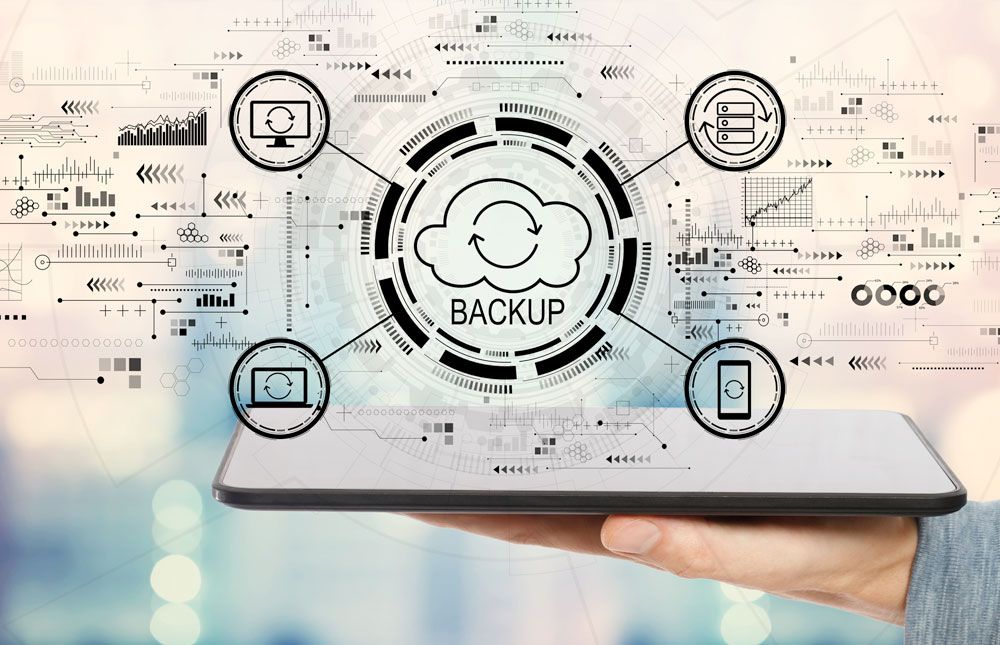Did you know that 93% of companies that lost their data center for 10 days or more due to a disaster filed for bankruptcy within one year of the incident? (Source: National Archives & Records Administration, Washington, DC.)
As a leading provider of backup and disaster recovery solutions for small to medium businesses (SMBs), it’s our responsibility to fully educate our customers on their business continuity options. We help protect businesses from data and financial loss with security and backup solutions that allow companies to quickly recover and remain operational. With decades of hard-earned experience and case studies under our belt, we have found that the hybrid cloud platform is the most reliable and efficient way for end users to back up their data securely and ensure that it is recoverable regardless of any disaster scenario.
With that in mind, this blog highlights everything you need to know about your cloud choices and the reasons why we have seen the most success with hybrid solutions.
Private, Public, and Hybrid Cloud Solutions
A hybrid cloud solution combines private (internal/on-premise) and public (external) cloud deployment models. With a typical private cloud solution, one would build, develop and manage their own cloud infrastructure. The most common deployments of private cloud solutions are in enterprise-level environments. Businesses that have the capital to fund a private cloud operation will usually purchase the necessary equipment, hire their own dedicated IT support teams, and build or lease their own data centers. This allows the company to have complete control over their cloud environment. The primary downside of a private cloud is that it is very expensive to implement and maintain. It also requires highly skilled engineers to manage the network.
In a public cloud scenario, one utilizes web-based applications and services. Hardware or software is not owned or maintained by the client, and resources are completely acquired from third party vendors. Google Apps, Salesforce, and Amazon Web services are all common examples of public clouds. With these deployments, end-users will work strictly through the internet via web-based portals. Generally, application data is not stored locally, and all relevant information is stored through the cloud provider.
While these solutions are cost-effective, the lack of control of data center resources, monthly fees, and increased support costs can hinder the viability that a public cloud will align with every business. The fact that business critical data is stored off-site can also be disconcerting for businesses. One must also consider the possibility that the cloud provider could go out of business, experience a service outage, be acquired by another company, or suffer a security breach. Any of these scenarios could spell disaster for a business’s data.
With a hybrid cloud model, aspects of both platforms are merged to form a single, unified platform. A business owns some form of local hardware, which is integrated with resources owned by a third party. Depending on what attributes of the business are being pushed to the cloud, there are many options for how a hybrid cloud platform can be constructed.
What is Hybrid Cloud Backup?
In the context of data backup, a combination of private and public backup solutions can be used to form an efficient and robust platform. Hybrid cloud vendors use their expertise to engineer enterprise-grade backup solutions that can be affordable for businesses of any size.
On the private cloud side, an end user would have a local device that acts as a Network Attached Storage (NAS) unit backing up data locally, while concurrently pushing data off-site to a secure, third party cloud. What sets these units apart from a typical NAS unit is that they also apply complex data deduplication, compression, file conversion, and other processes which are unique to each vendor. These processes help reduce storage space on local devices and off-site servers, keep local bandwidth reduction at a minimum, and optimize the backup process to make data recovery as efficient and quick as possible, both locally and in the cloud.
The public cloud side is comprised of the data center infrastructure developed by the cloud provider. Mirrored backup images from local backup devices are stored and archived in proprietary data centers, so they can be accessed in the event that backup records are not available locally (i.e. a disaster recovery scenario such as a hurricane or flood).
A desired benefit of most hybrid cloud backup solutions is the ability to achieve business continuity. Business continuity is a proactive way of looking at disaster preparedness. By having the proper tools and procedures in place, businesses can be assured that they will remain functional during a disaster scenario, large or small.
5 Benefits of Hybrid Cloud Backup
All in all, the hybrid cloud backup platform encapsulates the best of the private and public models to form a feature rich, highly efficient, and affordable system.
- Business Continuity
Business continuity, in the context of data backup, means that in the event of a disaster, cyber-attack, human error, etc., a company will never lose access to their critical data and applications. In the data backup industry, the lack of access to business-critical data is referred to as downtime. Business continuity is critical to any organization, because downtime can potentially bring operations to a halt while IT issues are being repaired. This can be extremely costly for any SMB to endure.
Read more about the cost of IT downtime here.
While proper business continuity planning is necessary throughout an organization, one technology that enables continuous up-time is virtualization of servers and workstations. A virtualized server or workstation is commonly referred to as a virtual machine or VM. This is essentially a copy of a workstation or server that runs on the hardware of a cloud server, as opposed to the hardware of the original production machine.
The VM is booted off of a production machine’s backup file that is housed in cloud servers. Once the VM is booted, every aspect of the virtual machine (i.e. operating system, applications, and files) will run exactly like the original machine did. This is invaluable in disaster scenarios, because if the original production machine is taken out of commission a business can transition to the VM immediately, while the original production machine is repaired or replaced. This is known as “failing over.” By allowing servers to failover to the cloud, a business is able to combat downtime and continue to manage their data and applications until the local IT infrastructure is fully operational. - Data Insurance
The hybrid cloud backup process generates a backup locally, and then a backup of the backup is replicated off-site. In some cases, data is replicated to two off-site locations. This provides a great deal of data security.
With local hardware, all data is in-house, protected by pre-existing firewalls, security protocols, and the encryption inherent to the backup device. By sending encrypted data to dedicated data centers, users ensure that there are redundant copies of the data secured off-site. The combination of local and off-site backups is important in the event of an unforeseen disaster and offers far greater peace of mind than simply pushing data over the web to a backup service provider or strictly housing data locally on a NAS or in a data center.
The level of security is very much like an insurance policy for your data. By having redundant copies of data located in multiple locations, hybrid cloud owners can rest assured that in the event of a disaster their data is protected and can be made available at any time. - Local Storage Flexibility
A benefit of hybrid cloud solutions is that the entire backup is not solely housed on-site. By leveraging the “infinite” storage space of the cloud, a business can decide how long they want their local retention to be, and scale it according to their needs. Files can be restored with ease whether they are on-site or off-site, so businesses do not need to worry about losing on-demand access to their data.
This offers a great benefit to smaller businesses, because it provides some flexibility if the local backup device has limited storage. In the event that a business starts to run out of space on their device, they can either consolidate incremental backups and/or prune off local copies of older backups that have already been replicated and secured off-site. As many SMBs do not have the resources to purchase, house, and maintain a backup infrastructure that is scalable to their data growth requirements, this reduces the necessity to purchase more local storage. Your data is safe regardless of the size and growth of your data. With a hybrid cloud backup solution, you will only be required to provide the amount of space required to back up your files locally. - Standards Compliance
For some industries, it is necessary to keep specific data backed up in order to comply with government regulated standards (i.e. HIPAA, PCI, SOX). Backup vendors are aware of these stringent regulations and have built their clouds to meet the needs of these verticals. The hybrid cloud platform lends itself perfectly because if a local backup device is damaged or destroyed, all files are already located off-site and can be accessed easily when necessary. This fulfills many requirements for contingency plans in emergency scenarios.
Archiving capabilities are mandatory to these industries as well. For example, medical entities governed by HIPAA regulations require a six-year retention policy for certain personal and medical records. By having redundant copies of backup records, companies protect themselves in the event of an audit. - Cost
The truth is, private clouds are expensive. Hardware acquisition, ownership, development, and implementation costs lead to large financial investments and the expenses and manpower costs required to maintain the solution can add up fast. Hybrid clouds, on the other hand, keep costs down. End users don’t need to own all the essential pieces of the puzzle (secure data center, servers to receive the data and virtualize in the cloud, etc.) With decreased power, cooling, and physical maintenance costs and some of the lowest and fairest monthly service/licensing fees in the industry, your initial investment is low.
Start Preparing for a Disaster with Clients First
After years of delivering intelligent business continuity to our customers, Clients First saw a need for an affordable, centralized disaster recovery solution. With the talent and experience in-house, we built our own hybrid cloud solution with storage size and performance flexibility: EverSafe.
EverSafe is a complete cloud backup and disaster recovery that ensures your data is backed up, protected, and recoverable at all times. Powered by the most advanced backup and cloud technology, it includes instant on-site and off-site virtualization, screenshot verification of backups, and intelligent business continuity solution built on one intuitive platform.
Easy to use and quick to install, EverSafe is available in different storage sizes and performance options to meet the needs of today and grow with your organization tomorrow. Discover how easy EverSafe business continuity and disaster recovery solution is to understand, install, and use by booking a quick demo with our infrastructure team today!



